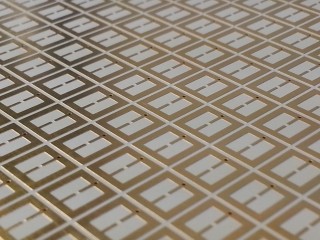Harvesting Energy from Electromagnetic Waves

O.Ramahi/U.Waterloo The metasurface used for collecting electromagnetic energy.
For our modern, technologically-advanced society, in which technology has become the solution to a myriad of challenges, energy is critical not only for growth but also, more importantly, survival. The sun is an abundant and practically infinite source of energy, so researchers around the world are racing to create novel approaches to “harvest” clean energy from the sun or transfer that energy to other sources.
This week in the journal Applied Physics Letters, from AIP Publishing, researchers from the University of Waterloo in Canada report a novel design for electromagnetic energy harvesting based on the “full absorption concept.” This involves the use of metamaterials that can be tailored to produce media that neither reflects nor transmits any power—enabling full absorption of incident waves at a specific range of frequencies and polarizations.
“The growing demand for electrical energy around the globe is the main factor driving our research,” said Thamer Almoneef, a Ph.D. student. “More than 80 percent of our energy today comes from burning fossil fuels, which is both harmful to our environment and unsustainable as well. In our group, we’re trying to help solve the energy crisis by improving the efficiency of electromagnetic energy-harvesting systems.”
Since the inception of collecting and harvesting electromagnetic energy, classical dipole patch antennas have been used. “Now, our technology introduces ‘metasurfaces’ that are much better energy collectors than classical antennas,” explained Omar M. Ramahi, professor of electrical and computer engineering.
Metasurfaces are formed by etching the surface of a material with an elegant pattern of periodic shapes. The particular dimensions of these patterns and their proximity to each other can be tuned to provide “near-unity” energy absorption. This energy is then channeled to a load through a conducting path that connects the metasurface to a ground plane.
The key significance of the researchers’ work is that it demonstrates for the first time that it’s possible to collect essentially all of the electromagnetic energy that falls onto a surface.
“Conventional antennas can channel electromagnetic energy to a load—but at much lower energy absorption efficiency levels,” said Ramahi. “We can also channel the absorbed energy into a load, rather than having the energy dissipate in the material as was done in previous works.”
As you can imagine, this work has a broad range of applications. Among the most important is space solar power, an emerging critical technology that can significantly help to address energy shortages. It converts solar rays into microwaves—using conventional photovoltaic solar panels—and then beams the microwave’s energy to microwave collector farms at designated locations on Earth. Japan is way out in front of rest of the world in this realm, with plans to begin harvesting solar power from space by 2030.
“Our research enables significantly higher energy absorption than classical antennas,” Ramahi said. “This results in a significant reduction of the energy harvesting surface footprint. Real estate is a precious commodity for energy absorption—whether it’s wind, hydro, solar or electromagnetic energy.”
Other key applications include “wireless power transfer—directly adaptable to power remote devices such as RFID devices and tags or even remote devices in general,” Ramahi noted.
The technology can also be extended to the infrared and visible spectra. “We’ve already extended our work into the infrared frequency regime and we hope to report very soon about near-unity absorption in those higher-frequency regimes,” added Ramahi.
The article, “Metamaterial electromagnetic energy harvester with near unity efficiency,” is authored by Thamer S. Almoneef and Omar M. Ramahi. It will appear in the journal Applied Physics Letters on April 14, 2015 (DOI: 10.1063/1.4916232). After that date it can be accessed at: http://scitation.aip.org/content/aip/journal/apl/106/15/10.1063/1.4916232
The authors of this paper are affiliated with the University of Waterloo.
ABOUT THE JOURNAL
Applied Physics Letters features concise, rapid reports on significant new findings in applied physics. The journal covers new experimental and theoretical research on applications of physics phenomena related to all branches of science, engineering, and modern technology. See: http://apl.aip.org
Contact Information
Jason Socrates Bardi
+1 240-535-4954
jbardi@aip.org
@jasonbardi
Media Contact
All latest news from the category: Power and Electrical Engineering
This topic covers issues related to energy generation, conversion, transportation and consumption and how the industry is addressing the challenge of energy efficiency in general.
innovations-report provides in-depth and informative reports and articles on subjects ranging from wind energy, fuel cell technology, solar energy, geothermal energy, petroleum, gas, nuclear engineering, alternative energy and energy efficiency to fusion, hydrogen and superconductor technologies.
Newest articles

Future AR/VR controllers could be the palm of your hand
Carnegie Mellon University’s EgoTouch creates simple interfaces for virtual and augmented reality. The new generation of augmented and virtual reality controllers may not just fit in the palm of your…

‘Game changer’ in lithium extraction
Rice researchers develop novel electrochemical reactor. A team of Rice University researchers led by Lisa Biswal and Haotian Wang has developed an innovative electrochemical reactor to extract lithium from natural…

The blue-green sustainable proteins of seaweed
… may soon be on your plate. The protein in sea lettuce, a type of seaweed, is a promising complement to both meat and other current alternative protein sources. Seaweed…



